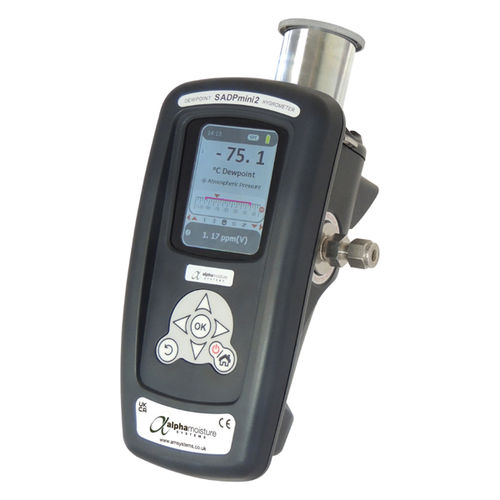In electronics manufacturing, compressed air systems, pharmaceuticals, food processing, and petrochemical plants, accurately measuring dewpoint is critical.
A portable dewpoint hygrometer is a compact, handheld instrument that measures the temperature at which water vapor condenses (the dewpoint) or directly reports moisture content in gases.
Compared with fixed sensors or indirect measurement techniques, portable hygrometers bring flexibility, speed, and reliability right to the operator’s hand. Below are the top benefits of deploying portable dewpoint hygrometers in industrial applications.
1. Accurate, Direct Measurement of Moisture
A primary advantage of portable dewpoint hygrometers is that they directly measure the dewpoint (or water vapor concentration) without relying on indirect proxies like relative humidity at ambient temperature. Direct dewpoint measurement avoids errors introduced by changing temperature, pressure, or gas composition.
This accuracy is essential where small moisture differences have large consequences — for example, preventing corrosion in instrument air lines, avoiding freeze-up in pneumatic systems, or protecting hygroscopic raw materials during storage and processing.
2. Fast, On-the-Spot Diagnostics
Portables excel at rapid troubleshooting. Operators can take immediate readings at any point in a system — after dryers, at downstream taps, at filter housings, or at suspect leak points — to determine whether moisture levels meet specifications.
This on-the-spot access speeds root-cause analysis, reduces downtime, and helps prioritize maintenance. When a compressor dryer is suspected of underperforming, a quick dewpoint check downstream can confirm the issue without waiting for lab analysis or sending gas samples away.
3. Portability and Flexibility
As the name implies, portability is a core benefit. A single instrument can be moved across multiple plants, lines, or storage areas, serving as a multi-purpose tool rather than requiring multiple fixed sensors.
This is especially valuable in facilities with diverse processes or where temporary monitoring is needed during startup, commissioning, or periodic audits. The same device can validate new installations, verify repairs, or confirm compliance during inspections.
4. Reduced Risk of Product Loss and Quality Defects
Moisture is a silent enemy in many industries. In pharmaceutical and food production, excess humidity can spoil batches or impact ingredient stability. In electronics manufacturing, moisture can cause solderability problems or corrosion.
Portable dewpoint hygrometers enable frequent checks at critical points (raw material receiving, cleanrooms, packaging areas), allowing teams to detect and mitigate moisture-related risks before they escalate into costly product loss or rework.
5. Precise Control of Compressed Air Systems
Compressed air is ubiquitous in industry, but it often carries moisture that must be managed. Portable dewpoint meters let maintenance teams verify dryer performance, detect water carryover, and confirm that point-of-use instruments receive appropriately dry air.
Because dewpoint is the correct indicator of dryness rather than relative humidity or simple visual inspection, portable readings help ensure pneumatic equipment and instrumentation operate reliably and avoid contamination or damage.
6. Compliance and Documentation
Many industrial processes are governed by standards or customer specifications that include moisture limits. A portable dewpoint hygrometer provides a simple way to document compliance during audits, supplier inspections, or regulatory reviews. Modern portable units frequently include data-logging, time-stamped records, and downloadable reports — all of which streamline proof-of-compliance and make it easier to trace and demonstrate moisture control practices.
7. Cost-Effective Maintenance and Predictive Insights
Using a portable hygrometer for periodic checks can be more cost-effective than installing and maintaining multiple fixed sensors. Portables reduce sensor proliferation and focus resources on targeted problem areas.
Beyond reactive troubleshooting, regular dewpoint spot checks support predictive maintenance: trends in dewpoint readings can reveal slowly degrading dryers, filter fouling, or emerging leaks — allowing repairs to be scheduled before failures occur.
8. Versatility Across Gases and Conditions
Many portable dewpoint instruments are designed to measure moisture in various gases (air, nitrogen, oxygen, natural gas, etc.) and across a range of pressures and temperatures. This versatility makes them suitable for diverse industrial environments — from low-pressure lab lines to high-pressure process streams — so a single tool can meet different departments’ needs without special calibration rigs or complex setups.
9. Ease of Use and Minimal Training
Modern portable hygrometers are user-friendly: intuitive menus, clear displays (often with both dewpoint and converted units like ppmv or g/m³), and quick-start sampling make them accessible to technicians and engineers alike.
Minimal training is required to get reliable results, empowering frontline staff to perform checks without always depending on specialized lab personnel. This democratization of measurement increases the frequency and coverage of moisture monitoring.
10. Safety and Reduced Process Disruption
Portable instruments often use safe sampling methods (e.g., low-flow sampling probes) that minimize the interaction with live process streams. That lowers the safety risk and reduces the need to shut down processes for testing. Quick, nonintrusive checks mean less production interruption, making dewpoint monitoring compatible with continuous or high-throughput operations.
Choosing and Using a Portable Dewpoint Hygrometer
To realize these benefits, select an instrument that matches your application needs: appropriate dewpoint range, compatibility with the gases you measure, pressure and temperature ratings, response time, and data-logging capabilities. Pay attention to sensor technology (chilled mirror versus polymer sensors, for example), calibration requirements, and ruggedness for industrial environments. Regular calibration and proper sampling technique (avoiding condensation in sample lines, allowing stabilization time) will keep readings accurate and actionable.
Conclusion
Portable dewpoint hygrometers are powerful, practical tools for industrial moisture control. They deliver accurate, direct measurements; accelerate diagnostics; lower the risk of product loss; and support predictive maintenance and compliance.
Their portability and ease of use let organizations concentrate measurement capability where it’s most needed, at the point of potential failure or quality risk. For any facility where moisture matters, adding a portable dewpoint hygrometer to the toolkit is a straightforward, high-impact investment in reliability, safety, and product quality.





Comments